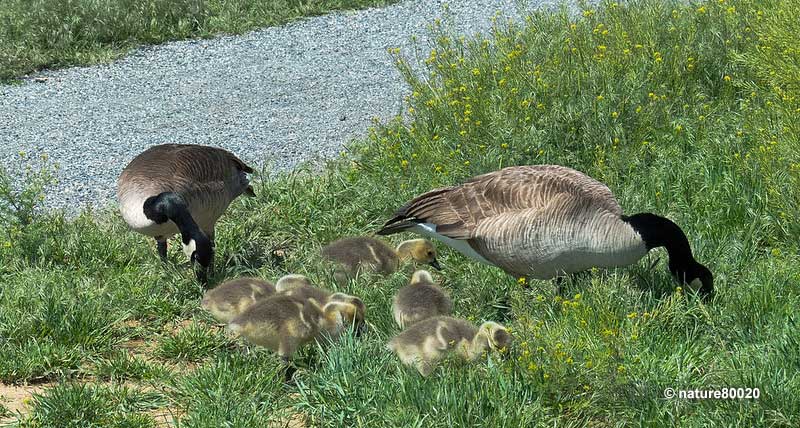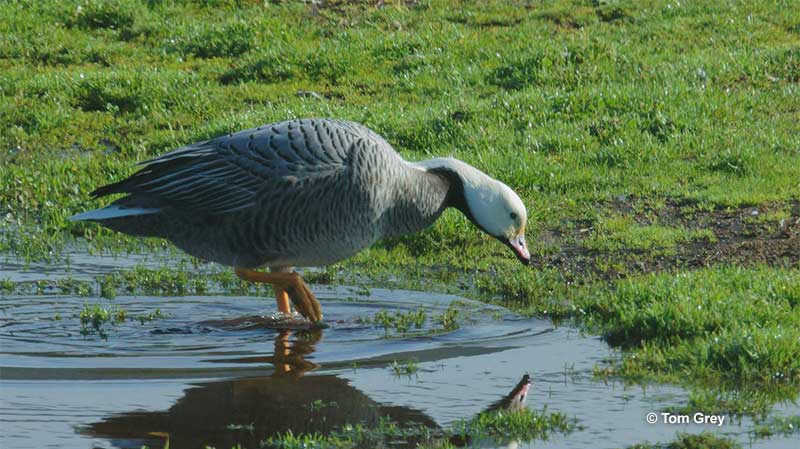
Geese are some of the easiest birds to watch. Visit just about any urban lake, and you’ll see some of these big waterfowl species!
They thrive on golf courses and we find big, noisy flocks migrating through and wintering on national wildlife refuges. In some places, thousands of geese also forage in farm fields!
Just what are those geese eating? How can so many of those large birds find enough food to survive?
See this article for answers to these and other questions about the diets of geese!
Key takeaways:
- Geese mainly feed on vegetation, but go for grains and fruit too.
- Like other waterfowl species, geese find a good portion of their food from water.
On this page
The Diet of Geese
Wild geese are primarily vegetarian. Similar to cows and deer, geese get a lot of their food by grazing on grass and other types of vegetation. This explains how they can become so common on golf courses and in parks. Essentially, these and other places with large areas of open lawns and a body of water or two provide geese with an endless supply of food.
Like a typical grazer, geese slowly walk along as they nibble bits of grass. One or more geese keep an eye out for predators and if they become alarmed, the big birds take flight or hurry back to the water.
Related: Do geese have teeth?
Once they are in the water, they don’t have to stop feeding either.
Geese eat aquatic vegetation like eelgrass, and the bulbs of various plants. However, instead of picking bits of vegetation from the surface, they often dip their heads below the water to pick bulbs and other plant matter submerged beneath them.
In migration and winter, when they can find them, geese eat similar things. However, they mostly feed on corn and other types of grain that they find in farm fields. In some places they also eat blueberries as well as other small fruits.
How Different Is Their Diet By Species?
Most geese eat various types of vegetation, and many feed on similar food items. For example, Canada Geese, Snow Geese, and Greater White-fronted Geese like to eat everything from sedges to the shoots and leaves of various plants, seeds, and grain.
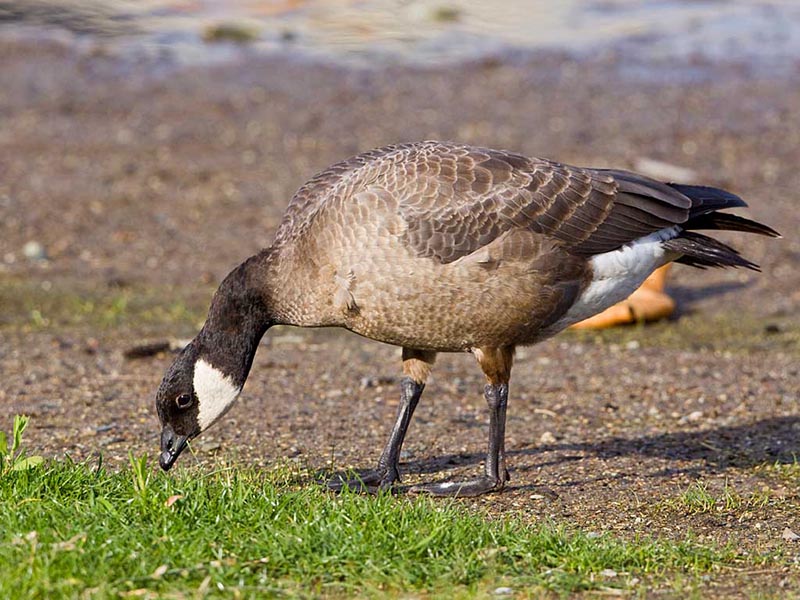
They can also feed in the same places, but there are some subtle differences. While Canada Geese walk in open areas to pick grass and eat other plant matter, Snow Geese like to feed in shallow water.
Large flocks use their beaks to dig and grub in muddy water so they can find tubers, stems, and other plant matter. When they discover food, the birds pull it out of the ground and quickly eat it.
Related: How to get rid of geese (in your garden)
Greater White-fronted Geese also forage for similar items but might eat more tubers pulled from dry ground.
Brant, a type of Arctic goose that winters in coastal waters, likes to feed on eelgrass and other aquatic plants. It forages for these food items in wet, intertidal zones. However, sometimes, like other geese, they also graze in grassy areas next to water.
One of the least common goose species has a different diet. Instead of grazing, the Emperor Goose of the Bering Sea mostly feeds on Blue Mussels and small clams.
What Do Goslings Eat?
Goslings (baby geese) have diets somewhat similar to those of their parents, and they also feed themselves. Similarly to ducks, grouse, and some other birds, the adult geese don’t bring food to their young.
Instead, mother geese lead their babies to good foraging areas. Shortly after they come out of their eggs, goslings begin to feed on grass, sedges, seeds, and other bits of plants.
They can pick at and eat all sorts of vegetable matter and some other types of food, but their diet mostly depends on where their mother brings them.
Although they do forage on their own, goslings also have a bit of extra help for the first day or two. During that time, they also take sustenance from the remnants of their yolk sac. However, shortly after, they have to find and eat lots of food to fuel their quick growth.
With that in mind, this might be why Snow Geese and some other geese species also eat small insects. This important source of protein is in addition to eating seeds and other plant matter.
Baby geese use their small beaks to snap at and catch little bugs from the air, and some goslings also pick them from vegetation.
Their Diet Compared To Other Waterfowl Species
The diets of geese have some similarities to other waterfowl species. However, in general, geese tend to graze more often and are mostly vegetarian.
Ducks
Ducks eat a variety of aquatic plants and animals. The diets they follow depend on the species and types of ducks involved, with ducks like wigeons and whistling ducks doing some of their foraging like geese.
These types of ducks get some of their food by grazing and picking seeds from plants. Dabbling ducks such as Mallards and Northern Shovelers also feed on plants but get their food by straining and picking bits of aquatic plants from the water.
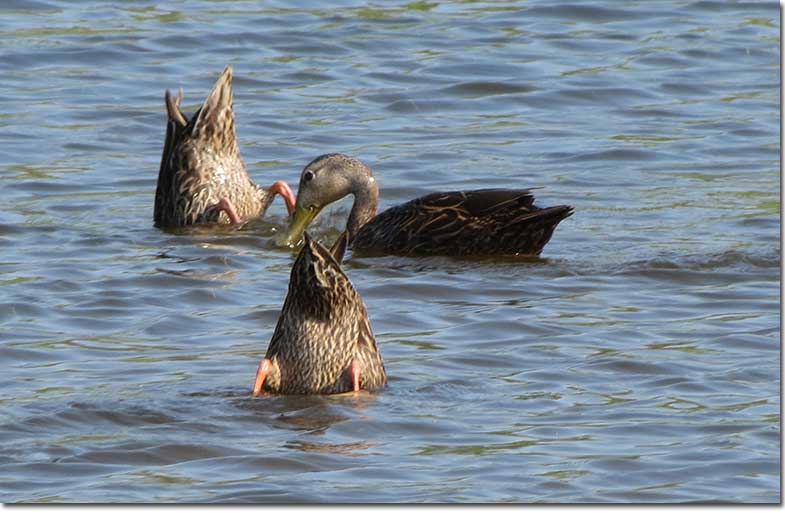
They also feed on small snails, insects, and other tiny aquatic animals, as well as tubers and grains.
On the other hand, scaup, goldeneyes, and other diving ducks eat mollusks and other aquatic invertebrates. They forage by diving below the waves and picking these food items from the rocky and muddy bottoms of lakes, rivers, and coastal waters.
Larger diving ducks such as scoters and eiders also forage in similar ways for mussels and clams.
There are also ducks that eat fish, a type of food rarely, if ever, eaten by geese. Mergansers, in particular, are highly adapted to pursuing and catching fish after underwater chases.
Some duck species also feed on nuts. Wood Ducks, in particular, like to eat acorns!
Swans
Swans are waterfowl that are very similar to geese but are even bigger and have longer necks. They also tend to be more aquatic than geese.
In some ways, the diets of these big, impressive birds are also similar to geese. Like geese, swans also feed on aquatic plants. They also eat eelgrass, algae, and other types of plants.
Similar to geese, swans get most of their aquatic plant food by dipping their long necks below the surface, and grabbing aquatic plants with their beaks. They then use their strong bills to rip the plant from the mud and bring it to the surface.
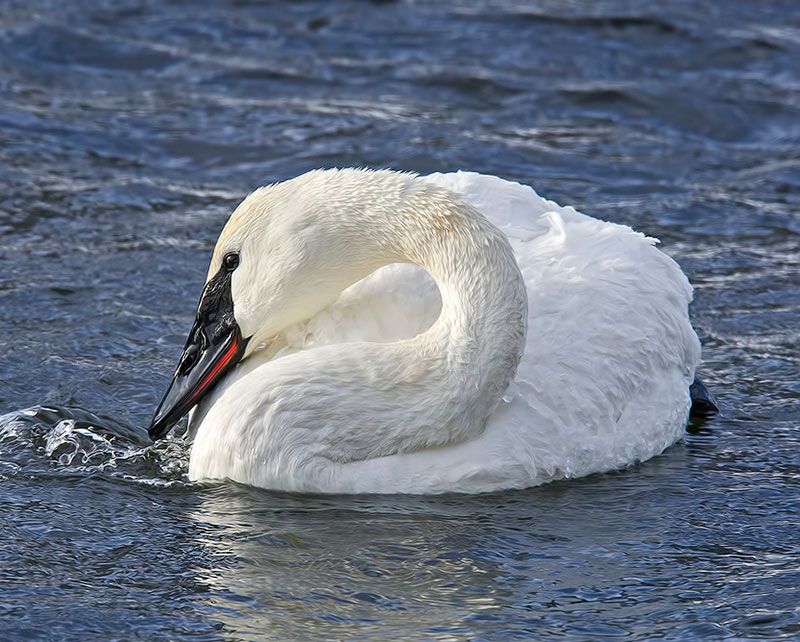
However, swans can also use their beaks to strain bits of plants from the surface of the water, and use their feet to scratch and stir up mud to find plant tubers.
Mute Swans also catch some small animals like snails, occasional fish, frogs, and tadpoles. Tundra Swans can eat some insects, especially young swans, but they mostly feed on aquatic plants and other types of plant matter.
In winter, these swans also eat tubers and other plants but have become accustomed to foraging in farm fields. In those places, the big birds eat spilled grain, corn, sugar beets, and rice.
Domesticated Geese
Like their wild ancestors, domesticated geese are primarily vegetarian. However, instead of eating aquatic plants and other vegetation found in wild places, captive geese are given other types of food.
Domesticated geese eat some commercial feed, but around 80% of their diet comes from foraging outside.
Captive geese graze on plants like thyme, dandelions, alfalfa, various weedy plants, and other plant species. They are also given peanuts, peas, and other vegetables.
Domesticated geese like to eat watermelon, berries, clover, and cucumbers too. They especially love oats, bananas, and grapes!
In winter, captive geese also feed on carrots, cracked corn, pumpkins, spinach, lettuce, hay, and barley and other grains.
Frequently Asked Questions
Do geese eat fruit?
Geese do eat fruit. They like to eat blueberries and watermelon as well as other types of fruit.
Do geese eat fish?
Most geese do not eat fish. Although some geese species may occasionally eat small fish, most are primarily vegetarian.
Can you feed a wild goose?
Yes, you can feed a wild goose. However, they should never be fed bread. Instead, wild geese should be given grains, grass, and beans.


